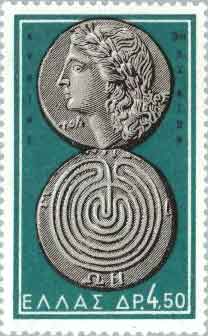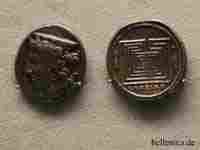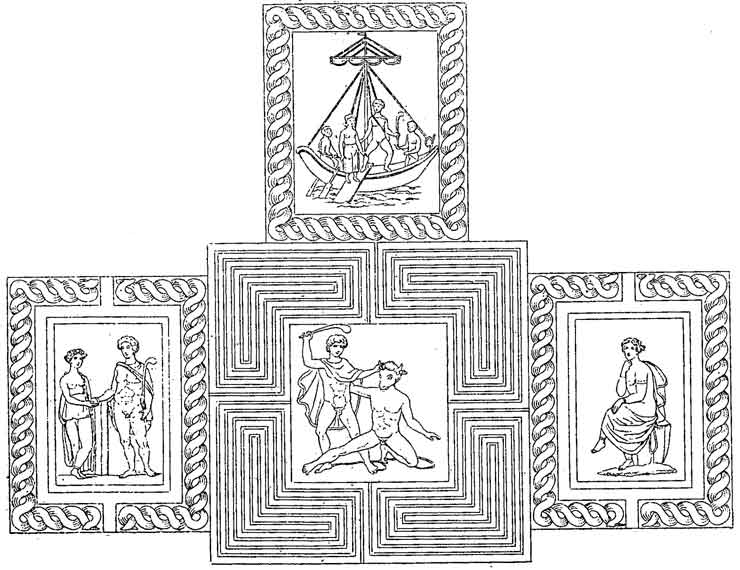
3rd BC Tetradrachm Coin from Crete, Apollo with the inscription (ΠΟΛΧΟΣ ) Polhos and a circular Labyrinth with the inscription (ΚΝΩΣΙΩΝ) Cnossus
... they made the Labyrinth which lies a little above Lake Moeris, in the neighbourhood of the place called the city of Crocodiles. I visited this place, and found it to surpass description; for if all the walls and other great works of the Greeks could be put together in one, they would not equal, either for labour or expense, this Labyrinth; and yet the temple of Ephesus is a building worthy of note, and so is the temple of Samos. The pyramids likewise surpass description, and are severally equal to a number of the greatest works of the Greeks, but the Labyrinth surpasses the pyramids. It has twelve courts, all of them roofed, with gates exactly opposite one another, six looking to the north, and six to the south. A single wall surrounds the entire building. There are two different sorts of chambers throughout—half under ground, half above ground, the latter built upon the former; the whole number of these chambers is three thousand, fifteen hundred of each kind. The upper chambers I myself passed through and saw, and what I say concerning them is from my own observation; of the underground chambers I can only speak from report: for the keepers of the building could not be got to show them, since they contained (as they said) the sepulchres of the kings who built the Labyrinth, and also those of the sacred crocodiles. Thus it is from hearsay only that I can speak of the lower chambers. The upper chambers, however, I saw with my own eyes, and found them to excel all other human productions; for the passages through the houses, and the varied windings of the paths across the courts excited in me infinite admiration as I passed from the courts into chambers, and from the chambers into colonnades, and from the colonnades into fresh houses, and again from these into courts unseen before. The roof was throughout of stone, like the walls; and the walls were carved all over with figures; every court was surrounded with a colonnade which was built of white stones exquisitely fitted together. At the corner of the Labyrinth stands a pyramid, forty fathoms high, with large figures engraved on it, which is entered by a subterranean passage. Herodotus, History Book 2
In Greek mythology, the Labyrinth was an elaborate maze constructed for King Minos of Crete and designed by the legendary artificer Daedalus to hold the Minotaur, a creature that was half man and half bull and was eventually killed by the Athenian hero Theseus. Theseus was aided by Ariadne, who provided him with a fateful thread to wind his way back again.
The term labyrinth is often used interchangeably with maze, but a maze is a puzzle with choices of path and direction, while a single-path ("unicursal") labyrinth has only a single, Eulerian path to the centre.
Labyrinth is a word of pre-Greek ("Pelasgian") origin absorbed by classical Greek, and is apparently related to labrys, a word for the archaic iconic "double axe", with -inthos connoting "place" (as in "Corinth"). The complex palace of Knossos in Crete is usually implicated, though the actual dancing-ground, depicted in frescoed patterns at Knossos, has not been found. Something was being shown to visitors as a labyrinth at Knossos in the 1st century AD (Philostratos, De vita Apollonii Tyanei iv.34, noted in Kerenyi, p 101 n. 171)


The oldest known examples of the labyrinth design are small simple petroglyphs (incised stones) perhaps dating back 3000 years. These spiralling labyrinth-pattern petroglyphs are found in numerous places across the world, from Syria to Ireland.
Greek mythology did not recall, however, that in Crete there was a Lady who presided over the Labyrinth. A tablet inscribed in Linear B found at Knossos records a gift "to all the gods honey; to the mistress of the labyrinth honey." All the gods together receive as much honey as the Mistress of the Labyrinth alone. "She must have been a Great Goddess", Kerenyi observes (Kerenyi 1976 p 91).

Theseus and the Minotaurus waiting in the Labyrinth, Burnes
That the Cretan labyrinth had been a dancing-ground and was made for Ariadne rather than for Minos was remembered by Homer in Iliad xviii.590–593 where, in the pattern that Hephaestus inscribed on Achilles' shield, one incident pictured was a dancing-ground "like the one that Daedalus designed in the spacious town of Knossos for Ariadne of the lovely locks". Even the labyrinth dance was depicted on the shield, where "youths and marriageable maidens were dancing on it with their hands on one another's wrists... circling as smoothly on their accomplished feet as the wheel of a potter...and there they ran in lines to meet each other."
The labyrinth is the referent in the familiar Greek patterns of the endlessly running meander, to give the "Greek key" its common modern name. In the 3rd century BC, coins from Knossos are still struck with the labyrinth symbol. The predominant labyrinth form during this period is the simple 7-circuit style known as the classical labyrinth (illustration, right).
The term labyrinth came to be applied to any unicursal maze, whether of a particular circular shape (illustration) or rendered as square. At the center, a decisive turn brought one out again. In the Socratic dialogue that Plato produced as Euthydemus, Socrates describes the labyrinthine line of a logical argument:
Then it seemed like falling into a labyrith: we thought we were at the finish, but our way bent round and we found ourselves as it were back at the beginning, and just as far from that which we were seeking at first."
"Thus, the present-day notion of a layrinth as a place where one can lose one's way must be set aside. It is a confusing path, hard to follow without a thread, but, provided one is not devoured at the midpoint, it leads surely, despite twists and turns, back to the beginning." (Kerenyi p 91).
In Antiquity the more complicated labyrinth pattern familiar from medieval examples was already developed. In Roman floor mosaics the simple classical labyrinth is framed in the meander border pattern, squared off as the medium requires, but still recognisable. Often an image of a bull-man, a minotaur, appears in the centre of these mosaic labyrinths. Roman meander patterns gradually developed in complexity towards the four-fold shape that is now familiarly known as the medieval form. The labyrinth retains its connection with death and a triumphant return: At Hadrumentum in North Africa, a Roman family tomb has a fourfold labyrinth mosaic floor, with a dying Minotaur in the center and a mosaic inscription: HICINCLUSUS.VITAMPERDIT "Enclosed here, he loses life" (Kerenyi, fig.31).
The full flowering of the medieval labyrinth design came about during the twelfth and thirteenth centuries with the grand pavement labyrinths of the gothic cathedrals, most notably Chartres and Amiens in Northern France and Siena in Tuscany. It is this version of the design that is thought to be the inspiration for the many secular turf labyrinths in the UK, such as survive at Wing, Rutland, Hilton, Cambridgeshire, the Alkborough Turf Maze, and at Saffron Walden in Essex.
Over the same period some 500 or more non-ecclesiastical labyrinths were constructed in Scandinavia. These labyrinths, generally in coastal areas, are marked out with stones most often in the simple classical form. They are thought to have been constructed by early fishing communities, to trap malevolent trolls/winds in the labyrinth's coils in order to ensure a safe fishing expedition. There are also stone labyrinths on the Isles of Scilly, although none of them are known to date back as far as the Scandinavian ones.
There are remarkable examples of the labyrinth shape from a whole range of ancient and disparate cultures. The symbol has appeared in all forms and media (petroglyphs, classic-form, medieval-form, pavement, turf and basketry) at some time, throughout most parts of the world, from Java, Native North and South America, Australia, India and Nepal.

Ancient Mosaic, The Story of Theseus and Ariadne
Modern Labyrinth Building
In recent years, there has been a resurgence of interest in the labyrinth symbol, which has inspired a revival in labyrinth building notably at Willen Park, Milton Keynes; Grace Cathedral, San Francisco; and Tapton Park, Chesterfield.
Modern Interpretations of the Greek Labyrinth
In modern imagery, the labyrinth is often confused with the maze, in which one may become lost.
The myth of the labyrinth has in recent times transformed into a stage play by Ilinka Crvenkovska in which exploring notions of a man's ability to control his own fate, Theseus in an act of suicide is killed by the Minotaur only to be killed himself by the horrified towns people.
The story has also since evolved into The Labyrinth (http://www.project-labyrinth.com) by Maja Hill - an interactive story using 3D computer graphics.
The Argentinian writer Jorge Luis Borges was entranced with the idea of the labyrinth, and used it extensively throughout his short stories. His modern literary use of the labyrinth has inspired a great many other authors in their own works (e.g. Umberto Eco's The Name of the Rose, Mark Z. Danielewski's House of Leaves).

Minotaur in a Labyrinth, c. 1800 (a centaur version)
Cultural Meanings
Cultural meaning and interpretation of the labyrinth as a symbol is quite interesting. Shortly put, prehistoric labyrinths serve either as traps for malevolent spirits or as defined paths for ritual dances. During Medieval times the labyrinth symbolized a hard path to the God with a clearly defined center (God) and one entrance (birth). Starting from the Renaissance labyrinths lose their central point: the person in the labyrinth is its center, a reflection of humanistic teachings. At last, nowadays the labyrinths moved into higher layers of reality, the Internet with its hypertext feature being a good example (the symbol of labyrinth merges with a symbol of book). Mazes often play a major role in modern computer games, e.g. the Lara Croft series.
Links
- The Labyrinth Society (people who walk, build, write about and study labyrinths) (http://www.labyrinthsociety.org/)
- Historical labyrinths, labyrinths as Catholic symbols (http://www.kensmen.com/catholic/labyrinths.html)
- Further reading
- Dionysos: Archetypal Image of Indestructible Life, Carl Kerenyi
- Jacob E. Nyenhuis, Myth and the Creative Process: Michael Ayrton and the Myth of Daedalus, the Maze Maker
See also : Greek Mythology. Paintings, Drawings
Retrieved from "http://en.wikipedia.org/"
All text is available under the terms of the GNU Free Documentation License
| Ancient Greece
Science, Technology , Medicine , Warfare, , Biographies , Life , Cities/Places/Maps , Arts , Literature , Philosophy ,Olympics, Mythology , History , Images Medieval Greece / Byzantine Empire Science, Technology, Arts, , Warfare , Literature, Biographies, Icons, History Modern Greece Cities, Islands, Regions, Fauna/Flora ,Biographies , History , Warfare, Science/Technology, Literature, Music , Arts , Film/Actors , Sport , Fashion --- |

